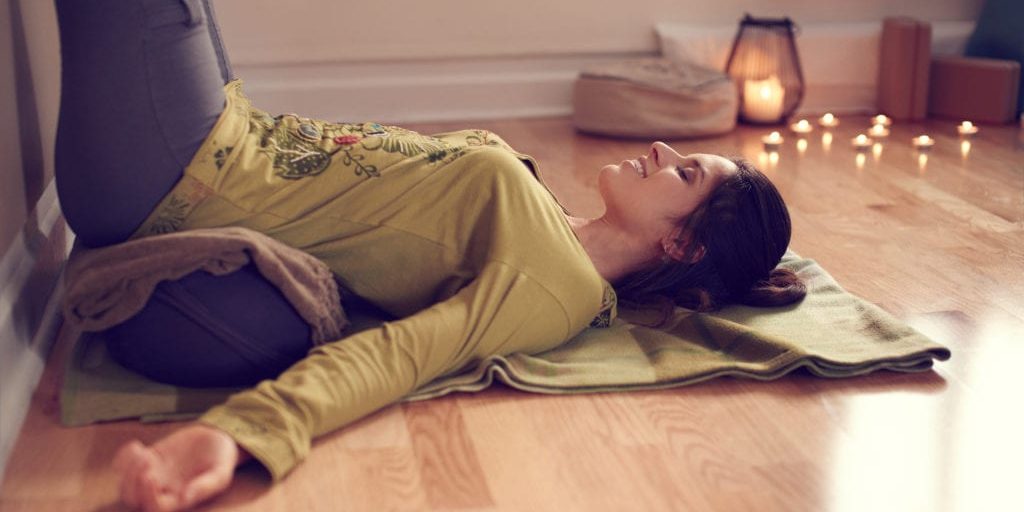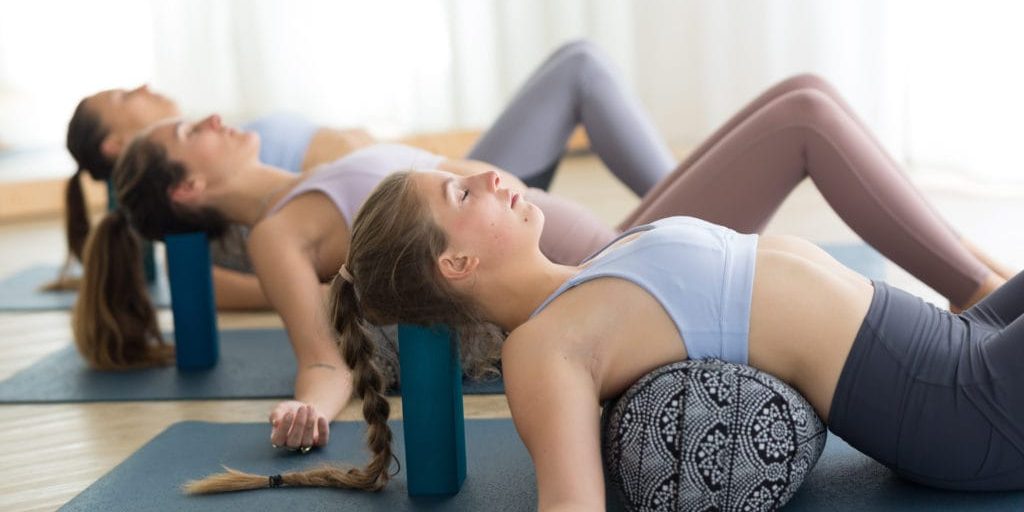Restorative Yoga
Restorative Yoga is a form of Yoga designed specifically to enable you to rest, relax and restore depleted energy to the body and mind. Restoration is at the core of this gentle, nourishing and deeply comforting practice which is suitable for all levels of age, health and experience. Unlike a general yoga class you may only practice a handful of poses during the session, taking the time to rest, relax and unwind through passive stretching and meditation on the breath. These classes would be ideal for anyone wishing to reduce stress levels or living with a long term health or chronic pain condition, Restorative Yoga can be the perfect antidote to modern life and a busy timetable that keeps many of us with high stress levels and a racing mind.

What is Restorative Yoga
Restorative Yoga is inspired by the teachings of BKS Iyengar who popularised the use of props to support Yoga Asana (poses) encouraging deeper opening and relaxation for his class participants. Judith Lasater, a senior Iyengar teacher devised restorative yoga classes using props that would soon become a regular feature on studio timetables across the globe.
Restorative Yoga is not affiliated to any particular school of Yoga so the structure of a class will vary from teacher to teacher but you can expect to find deeply supported holds of traditional poses of anything from 5 to 15 minutes. The use of props such as blocks, bolsters, blankets, straps, eye pillows and sandbags to encourage deeper relaxation is another key feature of a restorative class. Expect a comforting atmosphere, the lights will be dimmed and you will often hear soft music playing behind the calming voice of your teacher who may lead you in a guided meditation, sometimes called a Yoga Nidra to close the class.
Three Central Components of Restorative Yoga
- Props
The use of props for increased comfort and support, expect your teacher to use blankets, straps, eye pillows, bolsters and sand bags throughout the class to encourage you to move towards greater support and deeper relaxation.
- Deep Breathing
Focus on the breath to encourage you into a deeper meditative state and to calm the parasympathetic nervous system which controls the digestive system. Such deep relaxation that you may sometimes fall asleep during the session.
- Gravity
A focus on giving in and letting go to the support of gravity to deepen release and opening through the body and mind.

Restorative Yoga is a self care practice designed to comfort, calm and soothe, unlike other physical Yoga practices there is no need to exert energy or to hold challenging poses. The use of props enables the class participant to rest and reset both body and mind whilst lowering stress levels and relaxing into any held tension through the body.
The use of props and modifications makes this an ideal class for anyone with a long term health condition, disability or chronic illness. The teacher will take care that each individual is supported to access each pose in a way that is suitable for their own body, taking care to avoid any strain, pain or tension whilst focussing on deep breathing to support the process of rest and release.
What to Expect at a Restorative Yoga Session
The teacher will often begin the class by introducing you to the props you will need during the session and then move on to a short meditation to encourage a mindful mind-body connection throughout the class.
They may encourage you to notice where your attention is drawn and to imagine sending your breath to certain areas of tension within the body, using your exhale to soften and to relax into these areas.
Your teacher will skillfully and slowly guide you into each pose and its variations, maintaining a warm, calm and relaxing atmosphere throughout to promote your restful experience of the class.

Each class will be different but you are likely to come across these poses during your class
- Legs up the Wall (Viparita Karani)
This supported version of an inversion helps to ease tension in the legs and lower back. Placing a rolled blanket or bolster under the lower back takes pressure off the spine. You may also add a cushion under the head and place an eye pillow over the eyes.
- Child's Pose (Balasana)
Using props for support makes this a blissful version of the classic pose. Bringing a rolled blanket between the knees and a bolster under the chest can make this pose incredibly restful, opening the knees and inner thighs as well as providing release for the back
- Supported Bridge Pose (Setu Bandhasana)
This is another classic yoga pose that can be adapted for greater release, placing a rolled blanket or bolster below the sacrum allows an opening of the hips and lower back.
- Supported Savasana (Deep Relaxation/Corpse Pose)
The ultimate relaxation pose usually found at the end of a class. Placing a rolled blanket under the knees can bring release to the lower back for deeper rest.
You may be surprised by how difficult it is to relax and stay in the poses for an extended length of time. It’s not often that we are encouraged to rest and be unproductive as part of modern life so a little resistance is to be expected, you will find that after a short while the practice can bring you to a state of deep and blissful rest.
Due to the static nature of the postures you may wish to layer up with soft clothing and wear warm socks to maintain your body temperature during the class. Your teacher will usually provide you with the props you need for your session but you may decide to purchase your own if you enjoy the practice and would also like to spend some time in the poses between classes.
Effects and Benefits of a Restorative Yoga Class
Yoga has been proven to be one of the best ways to improve physical and mental health and Restorative Yoga is no exception to this rule. Restorative Yoga brings its own particular benefits especially to the parasympathetic nervous system which controls the “rest and digest” functions of the body.
- Stress Relief
the calm and quiet nature of this class encourages deep rest and relaxation. You are sure to feel the benefits of lowered cortisol levels and a quietening of the mind
- Improved digestion
you may notice an improvement in the functioning of your digestive system as this class will have a positive effect on the parasympathetic nervous system which controls your body’s ability to rest and digest.
- Improved sleep
this class encourages you to learn to switch off from a racing mind and use gravity to release tension, all of which can be practiced as part of your bedtime routine, helping you to get to sleep as well as stay asleep and wake up refreshed.
- Decreased pain and tension within the body
Regular class attendance can help you to manage your response to pain and notice any increase of unnecessary tension within the body. The gradual release of tension throughout the class can serve to help you understand and feel what is going on in your own body.
- Increased Concentration and Awareness
The long holds in a restorative yoga class can encourage you to learn and assimilate persistence and concentration which will begin to improve your general mental health.
- Increased Self Compassion
This practice enables you to spend time nourishing your mind and body and allowing yourself the gift of rest.
